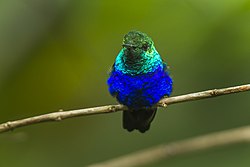Description
The violet-bellied hummingbird is characterized by the male's shimmering violet belly. [3] The rest of its body is just as brilliant; its back and crown being a metallic green. [3] The violet belly, however, is not shared between the sexes as this species exhibits sexual dimorphism. [7] The characteristics they do share include long, rounded tails, straight and short bills, and pink lower mandibles. [7] [3]
Plumage
Adult:
- The male violet-bellied hummingbird is more brightly colored than its female counterpart. [3] Its breast and belly is a violet blue while its back, crown, and throat is a metallic green. [3] While the rump is more of a bronze green. [3] The rectrices are a blue black while the belly and undertail coverts are a dull black with a blue/green sheen. [3] Around the tibia are white tufts which are framed by partly white spots on its belly. [3] The feathers on its wings are dusky with a purple sheen. [3] On average males are 7.5 cm long and weigh 3.4 g. [8] [3]
- The female violet-bellied hummingbird is more dull than its male counterpart. [3] Though its back, crown, and throat, is a similar metallic bronze green, its belly is a pale gray rather than a bright violet. [3] Its rump and uppertail coverts are more bronze than green while undertail coverts are a dull brown gray. [3] The rectrices can also be a blue black or a blueish green, and the outer rectrices are tipped with pale gray. [3] Similar to the males, the females' wings are dusky with a purple sheen. [3] Commonly in subspecies panamensis, the sides of the throat may be spotted with metallic green. [3] On average females are 7 cm long and weigh 3.0 g. [3] [8]
Juvenile plumage has only been documented for immature males. They appear similar to an adult female although they may have some patches of violet on their belly or a sparkling green foreneck. [3] [7]
The molt pattern of this species is also yet to be described.
Audio
 | Songs and calls
|
Similar species
Violet-bellied hummingbirds are very easily confused with woodnymphs. [3] The green crowned woodnymph, in particular, has a similar color and shape and their ranges overlap. [9] To tell them apart, you must check their size, color, and tail; violet-bellied hummingbirds are smaller, their backs are green instead of violet, and their tails are rounded, not notched. [3] Green crowned woodnymphs also have a violet forecrown. [3] Another similar species is the Sapphire-throated Hummingbird because of its colors. [3] However, it has a blue throat, a green belly, and a notched tail. [3]
Behavior and ecology
Breeding
As with many species of hummingbirds, violet-bellied hummingbirds seem to be polygynous. [3] Males mate with multiple females and attract them by singing on perches about 1–10 m high. [3] They may also fly in a 'u' shape in front of the females. [10] However, after mating, they leave the female to rear the young. [10] Individuals do not mate for life nor do they aggregate in flocks. [10]
The females are responsible for creating nests and rearing the young. [10] She creates a nest from plant fibers, animal hair and feathers in a shrub or a tree, approximately 1.2 to 4.2 m above ground. [10] [3] She will then incubate the clutch of two white eggs, each 8 by 13 mm. [3] Incubation lasts 15 days followed by a 20–22 day nestling period. [3] The chicks are altricial when they hatch and thus rely on their mother to feed and defend them. [10] If successful, violet-bellied hummingbirds go on to live for approximately 4.2 years. [11]
Food and feeding
Violet-bellied hummingbirds are primarily considered nectarivorous but may more accurately be called omnivorous. [3] They consume nectar from plants in the Rubiaceae, Ericaceae, Gesneriaceae (Besleria), and Fabaceae (Inga) families. [3] They also eat small arthropods, as do many other species of hummingbirds. [3] Males may defend their feeding territory from other males and large insects. [10] Although violet-bellied hummingbirds do not form flocks, they may congregate at fruit trees and feeders. [9] The violet-bellied hummingbird's predators are not known.
Threats
According to their IUCN Red List conservation status of least concern, the violet-bellied hummingbird does not seem to be threatened. [11] They are tolerant to disturbed areas such as forest edges. [3]
This page is based on this
Wikipedia article Text is available under the
CC BY-SA 4.0 license; additional terms may apply.
Images, videos and audio are available under their respective licenses.




